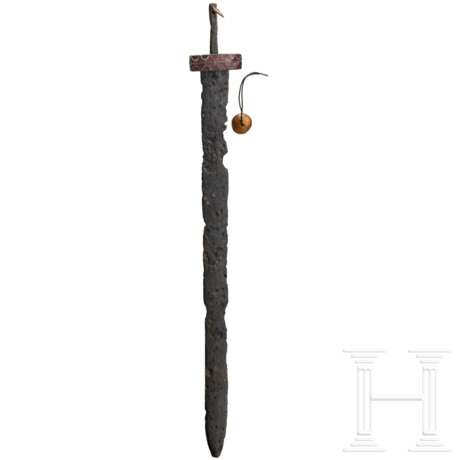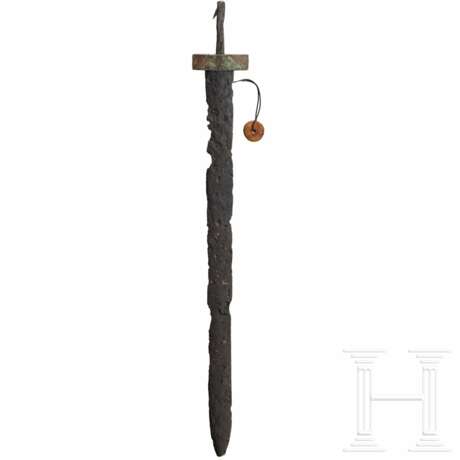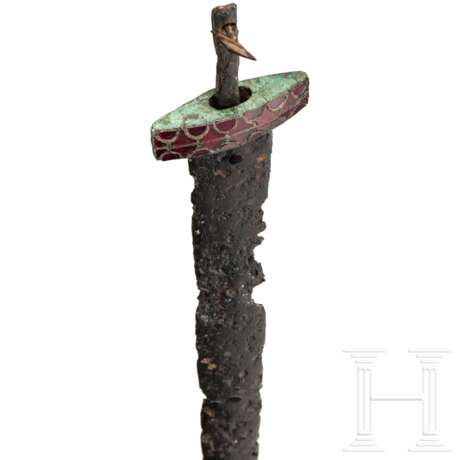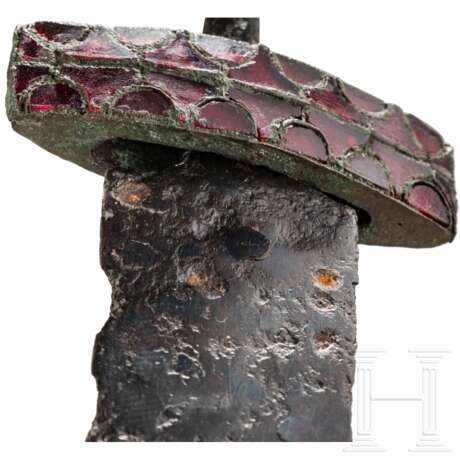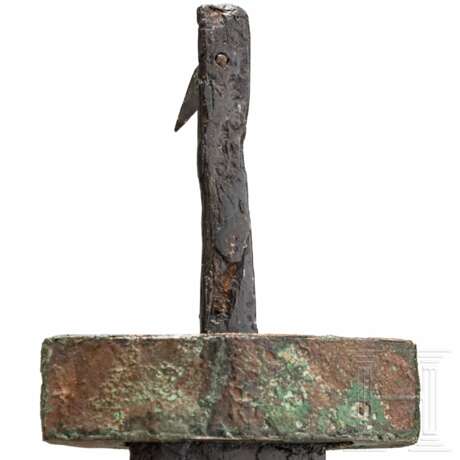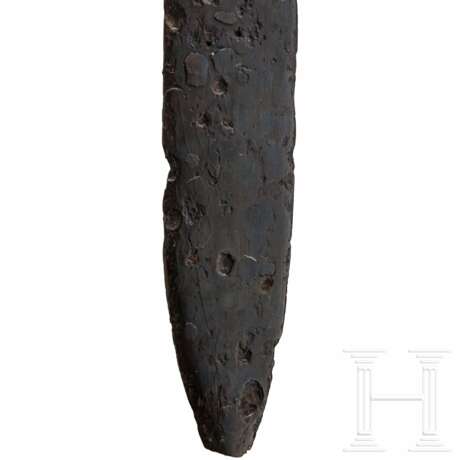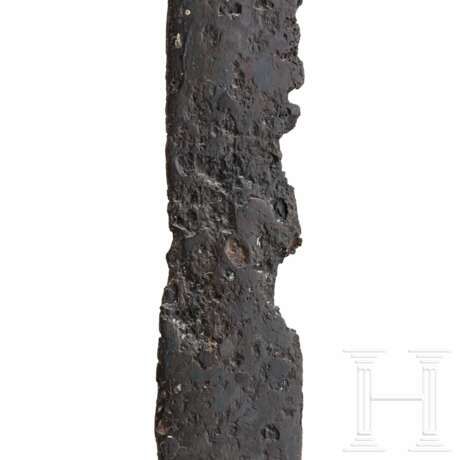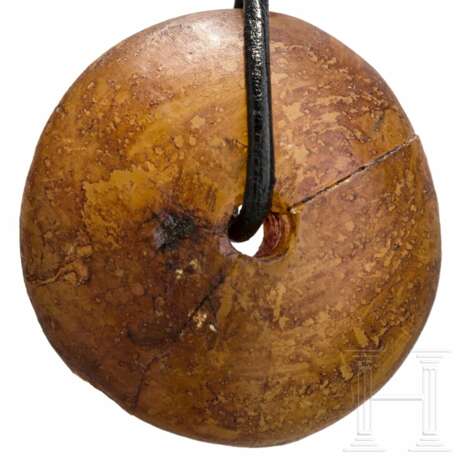Schwert mit Almadineinlagen auf Parierstange, Schwarzmeerraum, 1. Hälfte 5. Jhdt. n. Chr.
06.05.2025 10:00UTC +01:00
Classic
Starting price
6700EUR € 6 700
| Auctioneer | Hermann Historica |
|---|---|
| Event location | Germany, Grasbrunn / München |
| Buyer Premium | 25 % |
Archive
The auction is completed. No bids can be placed anymore.

ID 1416468
Lot 4116 | Schwert mit Almadineinlagen auf Parierstange, Schwarzmeerraum, 1. Hälfte 5. Jhdt. n. Chr.
Klinge mit flachovalem Querschnitt und nahezu parallelen Schneiden, die sich von oben unterhalb der Parierstange bis zur abgerundet eingezogenen Spitze geringfügig von 4,8 auf 4 cm verjüngt. Die ca. 1,5 cm breite Griffangel etwa 10 cm lang, die Klinge 65,2 cm. Im oberen Teil der Griffangel ein Kupferstift eingelassen, der ca. 1,5 cm auf die Schauseite hervorragt und oben mit einem rautenförmigen, verzinnten Kopf von 3,3 cm Länge versehen ist. Auf der Griffangel aufgeschoben eine komplex konstruierte, hohle, in der Aufsicht schiffsförmige Parierstange aus verlöteten Bronzeblechstreifen. Oben eine Vertiefung für die Hilze, unten für den Oberteil der Klinge, die dort zusätzlich mit organischem Material in den Zwischenräumen eingefasst war. Auf der Schauseite in zwei horizontalen Registern ein Zellwerk mit Almandineinlagen. Länge der Parierstange 9,3 cm, Höhe 3 cm. Die Klinge mit Korrosionsnarben und Ausbrüchen an den Schneiden. Die Parierstange mit den Einlagen ausgezeichnet erhalten. Gesamtlänge 75,2 cm. Dazugehörig eine typische flachkonische und mittig durchbohrte Schwertperle aus Bernstein mit geringfügigen Abplatzungen auf der Unterseite. Durchmesser 3,3 cm.
Typisches Prunkschwert der Völkerwanderungszeit aus dem Schwarzmeerraum, das eher repräsentativen Zwecken diente, da die komplex konstruierte, aber fragile Parierstange einer wirklichen Belastung im Kampf nicht standgehalten hätte. Für reale Kampfsituationen waren Schwerter mit massiv geschmiedeten Parierstangen aus Eisen bevorzugt.
Provenienz: Süddeutsche Privatsammlung. Aus alter englischer Privatsammlung (A.B. vor 1972), anschließend Sammlung Danielson (von Vater an Sohn vererbt). 1998 an H. F. in England verkauft. Danach im Kunsthandel und vom jetzigen Besitzer erworben.
A sword with almadin inlays on guard, Black Sea region, 1st half of the 5th century A.D.
A sword with almadin inlays on guard, Black Sea region, 1st half of the 5th century A.D.
Blade with a flat-oval cross-section and almost parallel edges, tapering slightly from 4.8 to 4 cm from the top below the guard to the rounded, retracted point. The approximately 1.5 cm wide tang is about 10 cm long, the blade 65.2 cm. A copper pin embedded in the upper part of the tang, protruding approx. 1.5 cm onto the obverse side and with a diamond-shaped, tinned head 3.3 cm long at the top. A complex, hollow guard made of soldered sheet bronze strips, spindle-shaped when viewed from above, is slid onto the tang. At the top a recess for the grip, at the bottom for the upper part of the blade, which was additionally framed with organic material in the interstices. On the obverse side in two horizontal registers, cell work with almandine inlays. Length of the guard 9.3 cm, height 3 cm. The blade with corrosion pitting and chipping at the edges. The guard with inlays in excellent condition. Total length 75.2 cm. Comes with a typical, flat conical amber sword bead pierced in the centre with minor chipping on the underside. Diameter 3.3 cm.
Typical ceremonial sword of the Migration Period from the Black Sea region, which served more for representative purposes, as the complex but fragile guard would not have withstood any real stress in battle. For real combat situations, swords with solid forged iron guards were favoured.
Provenance: A southern German private collection. From a formerly English private collection (A.B. vor 1972), afterwards from Collection Danielson (acquired from father to son). In 1998 sold to H. F. in England. Then acquired through the art trade and by the current owner.
Condition: II
| Auction house category: | Migration period and early middle ages |
|---|
| Auction house category: | Migration period and early middle ages |
|---|
| Address of auction |
Hermann Historica Bretonischer Ring 3 85630 Grasbrunn / München Germany | ||||||||||||||
|---|---|---|---|---|---|---|---|---|---|---|---|---|---|---|---|
| Preview | |||||||||||||||
| Phone | +49 (0)89 5472 649 0 | ||||||||||||||
| Fax | +49 (0)89 5472 64999 | ||||||||||||||
| Buyer Premium | 25 % | ||||||||||||||
| Conditions of purchase | Conditions of purchase | ||||||||||||||
| Business hours | Business hours
|
